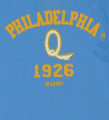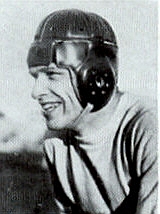Related Research Articles
The New York Yankees were a short-lived professional American football team from 1926 to 1929. The team was a member of the first American Football League in 1926, and later the National Football League from 1927 to 1929. They played their home games at Yankee Stadium. The team featured Red Grange at halfback.
The 1926 NFL season was the seventh regular season of the National Football League. The league grew to 22 teams, a figure that would not be equaled in professional football until 1961, adding the Brooklyn Lions, the Hartford Blues, the Los Angeles Buccaneers, and the Louisville Colonels, with Racine Tornadoes re-entering. Cleveland Bulldogs sat out the season, the Rock Island Independents defected to the upstart American Football League, and the Rochester Jeffersons suspended operations for the final time. The Akron Pros re-branded as the Akron Indians, the Duluth Kelleys as the Duluth Eskimos and the Buffalo Bison as the Buffalo Rangers. .

The Philadelphia Quakers were a professional American football team that competed in the first American Football League in 1926 and won the league's only championship.
The 1925 Chicago Bears season was their sixth regular season completed in the National Football League. The team was unable to improve on their 6–1–4 record from 1924 and finished with a 9–5–3 record under head coach George Halas earning them a seventh-place finish in the team standings, their worst showing to that date. However, the 1925 Bears were the most notable team in the young NFL's history to that point all because of the addition of college players, including Red Grange.
John F. McBride was an American football player who played the positions of halfback, fullback, and quarterback in the National Football League (NFL). He was born in Conshohocken, Pennsylvania. McBride played collegiately at Syracuse University where he finished second in the nation in scoring in his senior year to Heinie Benkert. McBride scored 90 points on 7 touchdowns, 11 field goals, and 15 extra points in his senior year.
The first American Football League (AFL), sometimes called AFL I, AFLG, or the Grange League, was a professional American football league that operated in 1926. It was the first major competitor to the National Football League (NFL). Founded by Charles "C.C." Pyle, (1882–1939), and General Charles X. Zimmerman, (1865–1926), as vice president and starring Hall of Fame halfback Harold Edward "Red" Grange, (1903–1991), the short-lived league with nine teams competed against the more established – then six-year-old – NFL, both for players and for fans. While Pyle's and Grange's New York Yankees team and the already established Philadelphia Quakers became reliable draws, the lack of star power and the uncertain financial conditions of the other seven teams led to the league's dissolution after one season.
Joseph Theodore Sternaman was a professional American football player, born in Springfield, Illinois, who played quarterback for nine seasons for the Chicago Bears and Duluth Kelleys. At 5'6" and 135 pounds he was called "the strongest little man I ever met" by sportswriter Grantland Rice. He played quarterback during the years Red Grange starred with the Bears. In 1926, he was the quarterback, head coach, and owner of the Chicago Bulls of the first American Football League. Joey was also the brother of Chicago Bears co-owner Dutch Sternaman.
The Boston Bulldogs were a professional American football team that competed in the first American Football League in 1926. Owned by Robert McKirby, the Bulldogs lasted only six games into the AFL season, playing one home game in Braves Field and one in Fenway Park. Coached by player-coach Herb Treat, the majority of the team played their college football in New England, Pennsylvania, and New York. The offense led by Joe McGlone was inconsistent, scoring a total of 20 points in its existence… 17 of which were tallied in one game. Erwin Gehrke and Carl Etelman shared the kicking duties. Bill Cronin, a tailback, scored the team's only offensive touchdown.

George Schly "Wildcat" Wilson was an American football player. After earning All-American honors in 1925 as a halfback for the University of Washington, he played professionally, including three seasons in the National Football League (NFL). Listed at 5 feet 10+1⁄2 inches (1.791 m) and 185 pounds (84 kg), he was inducted to the College Football Hall of Fame in 1951.

The 1925 National Football League (NFL) Championship, claimed by the Chicago Cardinals, has long been the subject of controversy, centering on the suspension of the Pottsville Maroons by NFL commissioner Joseph Carr, which prevented them from taking the title. The Maroons were one of the dominant teams of the 1925 season, and after defeating the Chicago Cardinals 21–7 on December 6, they came away with the best record in the league. However, Carr suspended and removed the team from the NFL after they played an unauthorized exhibition game in Philadelphia, on the grounds that they had violated the territorial rights of the Frankford Yellow Jackets. Chicago played and won two more games against weak NFL opponents, but were sanctioned because Cardinals player Art Folz hired four Chicago high school football players to play for the Milwaukee Badgers under assumed names to ensure a Cardinals victory.
The 1926 AFL season is the only season of the first American Football League. It started with nine teams, with the initial game of the season being played in front of 22,000 fans in Cleveland, Ohio, but by the end of the season, only four teams were still in existence: three teams owned or subsidized by league founder C. C. Pyle and star Red Grange and league champion Philadelphia Quakers. The initial lineup of teams included the traveling Wildcats and a charter member of the National Football League, the Rock Island Independents, which became a second traveling team after having poor attendance in its first three games.
The Los Angeles Wildcats was a traveling team of the first American Football League that was not based in its nominal home city but in Chicago, Illinois. Coached by Jim Clark, the team was designed to be a showcase for University of Washington star back George “Wildcat” Wilson. Compared to most traveling teams in professional football, the Wildcats were successful, compiling a 6–6–2 record in the only season of the team's – and the league's – existence.
The Newark Bears were a professional American football team that competed in the first American Football League in 1926 AFL season. Owned by the New Jersey Athletic Association, the Bears played their home games in Davids' Stadium. Coached by player-coach Hal Hansen, the majority of the team played their college football in Georgia and Florida.
The Cleveland Panthers were a professional American football team. They were an independent team founded in 1919 from the remains of the Youngstown Patricians. The Panthers played, with various degrees of success, continuously from 1919 and eventually, as fewer opponents played them each year after 1926, sputtered to a quiet folding in 1933.
The New York Yankees of the second American Football League was the second professional American football team competing under that name. It is unrelated to the Yankees of the first AFL, the Yankees of the third AFL, the Yankees of the American Association and the (later) Yankees of the All-America Football Conference. The Yankees played their home games in Yankee Stadium and Triborough Stadium in New York, New York. Jack McBride was the team’s head coach throughout its existence; Yankees' president James Bush served as president of the second American Football League in 1936.
The 1926 Rock Island Independents season was their only season in the first American Football League, after jumping to the upstart league from the National Football League. The team finished 2–6 in league play and 2–7–2 overall, earning them seventh place in the league. The Independents struggled to bring in 5000 fans to its home games and later became a traveling team after having poor attendance in its first three games. The AFL folded after the 1926 and the Independents did not rejoin the NFL. They instead played as a minor, semi-pro team in 1927, then folded.
References
- ↑ David S. Neft, Richard M. Cohen, and Rick Korch, The Football Encyclopedia: The Complete History of Professional Football, From 1892 to the Present (St. Martin's Press 1994), ISBN 0-312-11435-4
- ↑ George Gipe, The Great American Sports Book (Doubleday 1978) ISBN 0-385-13091-0
- ↑ "A.F.L. Fields Nine Teams The New York Times , July 17, 1926
- ↑ David S. Neft, Richard M. Cohen, and Rick Korch, The Football Encyclopedia: The Complete History of Professional Football, From 1892 to the Present (St. Martin's Press 1994), ISBN 0-312-11435-4
- ↑ David S. Neft, Richard M. Cohen, and Rick Korch, The Football Encyclopedia: The Complete History of Professional Football, From 1892 to the Present (St. Martin's Press 1994), ISBN 0-312-11435-4
- ↑ 1926 American Football League from Elias Sports Bureau and Pro Football Research Association Linescore Committee Archived June 5, 2015, at the Wayback Machine
- ↑ The Grange League – Professional Football Researchers Association (1997)
- ↑ David S. Neft, Richard M. Cohen, and Rick Korch, The Football Encyclopedia: The Complete History of Professional Football, From 1892 to the Present (St. Martin's Press 1994), ISBN 0-312-11435-4
- ↑ George Gipe, The Great American Sports Book (Doubleday 1978) ISBN 0-385-13091-0
- ↑ David S. Neft, Richard M. Cohen, and Rick Korch, The Football Encyclopedia: The Complete History of Professional Football, From 1892 to the Present (St. Martin's Press 1994), ISBN 0-312-11435-4
- ↑ John Thorn and Pete Palmer with Michael Gershman, Total Baseball: The Ultimate Encyclopedia of Baseball, Third Edition (HarperPerennial 1993) ISBN 0-06-273189-0